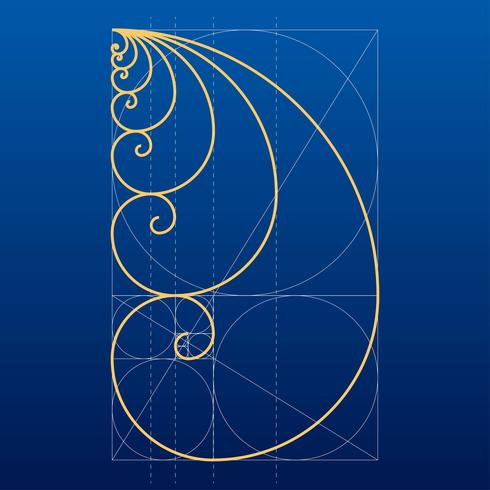

This was all based on attempts to codify human and other natural proportions going back to Vitruvius & Alberti in mathematical terms and expressions - today we might add our understanding of the concept of fractility to this toolset (the degree of brokenness, roughness or bifurcation of an entity expressed as a ratio with its length or volume) but for the usecase of simple graphic design, it would perhaps be overkill. If you nest Golden Rectangles, you get the Fibonacci Spiral (the spiral's curve passing through one intersection point of the implied squares when you nest two Golden Rectangles), and if you fill each implied square with a tangent circle you get a Fibonacci sequence of circles - A.K.A. The Fibonacci sequence of numbers gives rise to the Fibonacci spiral, and the Golden Ratio gives rise to the Golden Rectangle. In the case of using Fibonacci and Golden Ratio systems, the goal is to connect your design's proportions to more broadly observed, understood and recognisable proportions from nature. This proportioning system, or its use can be entirely arbitrary, or may synthesise a naturally-based system and an arbitrary system (Le Cobusier, I'm looking at you & Modulor) and may be of limited use for any specific design task, or may be of great assistance. The basic idea of a proportioning system is to connect the proportions (ratios of relative sizes) of your design elements (whether those are graphic elements on a page or display or an array of columns in a garden or the decorative details wrapping around the bases of engaged pilasters which frame and form a building portico) to some over-arching concept to give your design visual consistency. These can be overlaid on photos, or on design blank sheets for guidance in initial ideation - the use is multivariate and as individual as the designer is. here we go!ġ) I use a set of Golden Ratio / Fibbonacci overlays when I design logos, and sometimes even page layouts, websites and other graphic design layouts (I have also used this concept pretty broadly in my other life, as an architectural designer, where its use is quite common, and is still taught in many architectural schools) and these are how those overlays appear: OK - I'm gonna take a quick stab here, as I think this post isn't quite a duplicate of some of the other Golden Ratio or Fibbonacci questions. Maybe its just the frustrations within but it often seems to be that many resources try and make the Spiral fit an image rather than the Spiral informing the ideation and creative process.Īny clarification, on this, would be greatly appreciated since I am at a loss at its usage. What exactly should I look out for and what would I need to ensure was in each Box for example.

When it comes to the Grid approach, would I be right in saying that each Box is simply in proportion of its adjacent Boxes by a ratio of 1.618? Does it matter where the Grids are and how many Boxes the image includes? For example, I could place many more Boxes within the Grid approach, as long as they follow the 1.618 ratio? Obviously, the more Boxes being added, the smaller they would have to be.Īssuming I have understood the Mathematics/Technicalities of the Golden Ratio Grid, I am still at a loss of its implementation. Using Photoshop, I then placed the Spiral on top of the images as an overlay as follows.


Where I am at a loss, is on where and how these ratios and spirals are integrated into the design process.ĭue to not actually getting anywhere with my understanding, I thought I would look at some images that claim to abide by these ratios and spirals. I understand how ratios and proportionality works. I have read and watched countless resources but my only taking is that the ratio is set at 1:1.618 and its purpose is to help inform the creation of something that is visually pleasing. Through my learning, I have come across the term 'Golden Ratio' and the 'Golden Spiral'. I am not formally educated in this principle, where I am self learning through a variety of online resources. I will be looking to create a Logo very shortly.


 0 kommentar(er)
0 kommentar(er)
